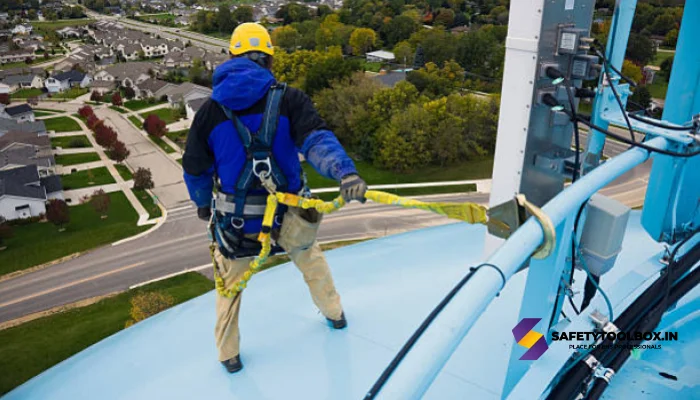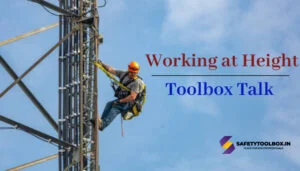Working at height means working on any height from which there is a risk of fall. More Than 30% of industrial accidents are because of falls from height. out of which almost 60% of falls resulted in a death. Common causes include falls from ladders, fall from scaffoldings, fall from structure, fall from the fragile roof, etc. majority activities in which risk of fall from height include painting work, roof sheeting work, scaffold erection work, cable laying work, cable dressing work, lighting work, etc.
Hazard of working at Height
- Fall from height
- Fragile roof
- Inadequate Ladder
- Unstable platform
- Overhead electrical power lines
- Overhead cranes
- Tough Weather (high wind flow, rain, extreme heat etc.)
- Slip & trip by tools or material stacking on platform
- Material falls from height
- Inadequate access
- Poor illumination
Control for Working at Height
- Elimination: Avoid work at height if possible
- Substitute: Use scissor lifts, Cherrypicker (Boom lifters), scaffolds for working at height instead of working through unsafe access
- Engineering control: Use crawling board, edge protections, railings etc. as a engineering control
- Administrative control: Provide training related to work at height, Permit system for work at height
- Personal protective equipment (PPE): Use safety belt, retractable fall arrester, lifeline for height work (learn more about PPE from here)

Precaution required before working at Height
- Inspect work site prior to day of work
- Mark or covered fragile surface with appropriate guard rail before assigning work
- Prepared pre job plan for work
- Identify hazard of work and decide appropriate controls for each hazard before starting of work
- Explain each hazard to workmen before starting of job
- All platform or ladder should be inspected as per your plant procedure
- Ensure safety belts are free from any damages, all it’s hooks, strips are in healthy conditions
- Identified walkable and non-walkable area if work has been carried out on the roof
- Make sure all non-walkable area must be clearly marked and barricades to restrict workers movement on that area
Ensure following points while Working at Height
- Use engineering controls and do as much as work from ground level
- Work Permit has been required with all due precautions (i.e. PPEs, structure, platform, weather condition, illumination, area surrounding etc.)
- Mobile or static platform should be safe and secure use additional outriggers in mobile scaffolds to improve stability of scaffolds
- Work platforms have adequate capacity for withstanding weight of people, their equipment and materials
- Adequate guardrail, barriers or any other means of protection are required
- A safe intermediate platform is required, where access ladders rise above 9 m
- All Scaffold must be approved by scaffolder or decided authority
- Ladders are rested at the correct angle (maintain 4:1 ration), extend at least 1 m above the stepping-off point and are secured, top and bottom. (for more details of ladder safety click here)
- ladders must have valid inspection tag, or it must be approved
- Safety belt required while working at height above 1.8 meter
- Avoid work near to the HT or LT Line
- Ensure appropriate access of egress for emergency
- Make sure all tools or equipment should be properly tied to avoid fall from height
- Provide toe guard or edge protection on roof on platform to secure unwanted material falling from height
- While working near fragile roof provide appropriate anchorage for safety belt anchoring
- Use fall-arrest devices, safety harnesses, lifeline, H-line or safety nets to prevent falls
- Always supply and use anchorage points for safety harnesses and ladders
- Work at height not allowed if weather condition is adverse
- Clean safety shoes before stepping up at heights to avoid slip
- Do not overreach on platforms or ladder
- Do not accumulate rubbish on platform
- Never use forklift for working on height

Safe Working Practices for Working at Height
- All person engaged in height work are trained and competent
- Conduct medical examination of workers ( He must be physically and mentally fit for working at height) before working at height more than 50 foot
- Select appropriate equipment and conduct risk assessment for work
- Use crawling boards or ladders on roof if roof is fragile or the slope of roof is above 10 degrees
- Restrict unauthorized access to roofs, chimney, terrace, stacks etc.
- Use ladders for light work of short duration, when no safer alternative identified
- Inspect & maintain all equipment regularly before use and after adverse conditions
- All opening must be guarded or covered to avoid fall
- Secure your tools with your cloth to avoid slipped or fall during height work
- Ensure area must be barricaded, if any height work activities are carryout
- Use a chute for lower materials from height to safe movement of material during work at height
- See following video to learn more about work at height safety
- Use of mobile is strictly prohibited during work at height as mobile can distract persons cognitive ability which can lead to the accidents so keep mobile out of work
Remember: There is no safe height to fall from, so avoid working at height when possible
For more Safety toolbox talk click here
Follow our LinkedIn page for more learning on Safety, health and Environment https://www.linkedin.com/company/safetytoolbox/
Subscribe our Weekly newsletter on safety, health and environment https://www.linkedin.com/newsletters/safety-toolbox-6972274010759794688

Mr. Petel, this is very important observation as regards to working at height toolkit/box. Many deaths, lost of limbs, injuries, accidents & incidents that are being witnessed in our industrial settings globally today are due to lack of safety consciousness on the side of employers, employees, CEOs, managers, &organistions who normally breached their diverse duties of care in terms of training , employment processes among others.
Thank you.
Sincerely yours,
Joseph Iorlaphine Ulaha,
+2348074220047,
E-mail: Joseph.ulaha@gmail.com,
Abuja, Nigeria.
Yes Joseph, very true
I agree. Most workers make mistakes of working at height without any training. In Uganda..they call it Jua Kali. Loosely translated..using common sense to complete an assignment without necessarily going through some kind of training!!
Stay safe always..
I need work. Driving or carpenter.
Salary 180 visa 20
merhaba düşüşte otomatik açılam emniyet kemeri lazım bize